齐白石英文介绍解析
- 格式:ppt
- 大小:2.80 MB
- 文档页数:13
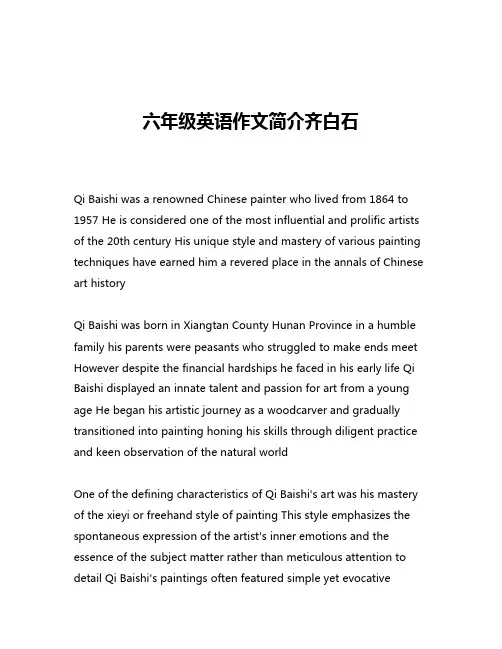
六年级英语作文简介齐白石Qi Baishi was a renowned Chinese painter who lived from 1864 to 1957 He is considered one of the most influential and prolific artists of the 20th century His unique style and mastery of various painting techniques have earned him a revered place in the annals of Chinese art historyQi Baishi was born in Xiangtan County Hunan Province in a humble family his parents were peasants who struggled to make ends meet However despite the financial hardships he faced in his early life Qi Baishi displayed an innate talent and passion for art from a young age He began his artistic journey as a woodcarver and gradually transitioned into painting honing his skills through diligent practice and keen observation of the natural worldOne of the defining characteristics of Qi Baishi's art was his mastery of the xieyi or freehand style of painting This style emphasizes the spontaneous expression of the artist's inner emotions and the essence of the subject matter rather than meticulous attention to detail Qi Baishi's paintings often featured simple yet evocativebrushstrokes that captured the spirit and vitality of his subjects whether they were animals insects plants or landscapesAnother hallmark of Qi Baishi's art was his deep appreciation and understanding of traditional Chinese culture and philosophy He drew inspiration from classical literary and artistic works as well as Taoist and Buddhist teachings which infused his paintings with a profound sense of harmony and balance His depictions of everyday objects and scenes were imbued with a sense of timelessness and universality that transcended the mundaneThroughout his long and prolific career Qi Baishi experimented with a wide range of subjects and techniques He excelled at painting shrimps crabs and other aquatic creatures which he rendered with remarkable accuracy and attention to detail His depictions of these creatures were not merely realistic but also imbued with a sense of playfulness and whimsy that delighted his viewersIn addition to his mastery of traditional painting techniques Qi Baishi was also renowned for his innovative use of materials He often incorporated unconventional elements such as salt sand and even his own fingernails into his paintings creating unique textures and effects that added depth and complexity to his work His experiments with materials and techniques reflected his constant pursuit of artistic innovation and his refusal to be bound by traditionalconventionsDespite his immense talent and popularity Qi Baishi remained humble and down-to-earth throughout his life He continued to work tirelessly even in his old age producing thousands of paintings and calligraphic works that were highly sought after by collectors and art enthusiasts alike His unwavering dedication to his craft and his ability to find inspiration in the most mundane aspects of life were a testament to his artistic geniusQi Baishi's influence extended far beyond the realm of art he was also a respected calligrapher and seal carver whose works were highly prized by connoisseurs His calligraphic style was characterized by a bold and expressive brushwork that captured the essence of the written word His seal carvings were equally impressive featuring intricate designs and inscriptions that added an additional layer of meaning and depth to his artistic creationsIn addition to his artistic accomplishments Qi Baishi was also known for his strong moral character and his unwavering commitment to social justice He was deeply concerned about the plight of the common people and used his art as a means of social commentary often depicting scenes of rural life and the struggles of the working class His paintings were not merely aesthetic objects but vehicles for expressing his political and social viewsQi Baishi's legacy as one of the most influential artists of the 20th century continues to be celebrated and revered both in China and around the world His paintings are highly sought after by collectors and museums and his artistic style has inspired countless artists and art enthusiasts to explore the rich and diverse traditions of Chinese artIn conclusion Qi Baishi was a truly remarkable artist whose life and work have left an indelible mark on the cultural landscape of China and beyond His unique style his innovative techniques and his deep engagement with traditional Chinese culture and philosophy have all contributed to his enduring legacy as one of the most celebrated artists of the modern era。
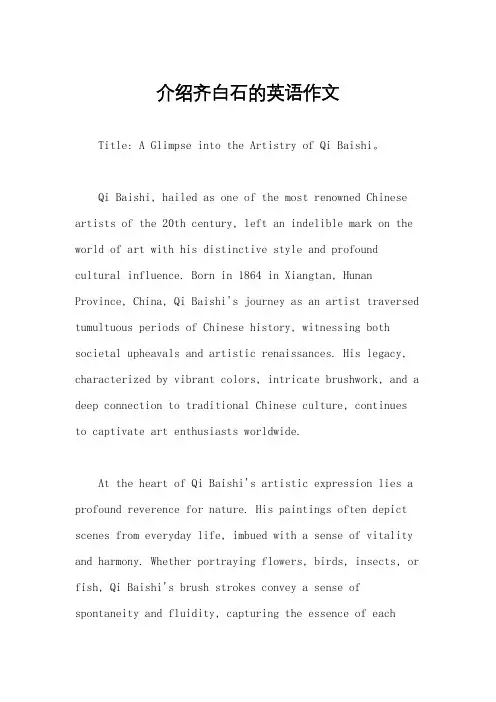
介绍齐白石的英语作文Title: A Glimpse into the Artistry of Qi Baishi。
Qi Baishi, hailed as one of the most renowned Chinese artists of the 20th century, left an indelible mark on the world of art with his distinctive style and profound cultural influence. Born in 1864 in Xiangtan, Hunan Province, China, Qi Baishi's journey as an artist traversed tumultuous periods of Chinese history, witnessing both societal upheavals and artistic renaissances. His legacy, characterized by vibrant colors, intricate brushwork, and a deep connection to traditional Chinese culture, continues to captivate art enthusiasts worldwide.At the heart of Qi Baishi's artistic expression lies a profound reverence for nature. His paintings often depict scenes from everyday life, imbued with a sense of vitality and harmony. Whether portraying flowers, birds, insects, or fish, Qi Baishi's brush strokes convey a sense of spontaneity and fluidity, capturing the essence of eachsubject with remarkable precision. His mastery of the "gongbi" and "xieyi" techniques, representing meticulous detail and expressive freedom, respectively, showcases his versatility and artistic prowess.One of Qi Baishi's most iconic motifs is the humble shrimp. In his paintings, shrimp symbolize resilience, perseverance, and the beauty of simplicity. Through subtle variations in brushwork and shading, Qi Baishi infuses these small crustaceans with life-like vitality, elevating them from mere subjects to embodiments of profound philosophical ideals. His shrimp paintings, characterized by intricate detailing and dynamic compositions, epitomize his ability to transform the ordinary into the extraordinary.Beyond his technical skill, Qi Baishi's artistry reflects his deep spiritual connection to Chinese culture and tradition. Influenced by Daoist philosophy and Confucian ethics, his works often convey moral lessons and philosophical insights. Through allegorical imagery and symbolic motifs, Qi Baishi imparts timeless wisdom,inviting viewers to contemplate the beauty of nature and the transient nature of existence. His art serves as a bridge between past and present, preserving ancient wisdom in a modern context.In addition to his traditional Chinese paintings, Qi Baishi was also a master of calligraphy. His elegant brushwork and graceful strokes earned him widespread acclaim as a calligrapher, further solidifying his status as a multifaceted artistic genius. Whether conveying poetic verses or philosophical aphorisms, Qi Baishi's calligraphy embodies the essence of Chinese literary tradition, demonstrating a deep appreciation for the written word as an art form.Qi Baishi's influence extends far beyond the realm of art, encompassing politics, education, and cultural exchange. Throughout his life, he remained deeply committed to promoting traditional Chinese culture and fostering artistic innovation. His role as a cultural ambassador earned him accolades both at home and abroad, solidifying his legacy as a global icon of Chinese art.In conclusion, Qi Baishi's artistic legacy continues to inspire and enchant audiences worldwide. Through his mastery of brush and ink, he captured the beauty of nature and the essence of Chinese culture with unparalleled skill and grace. As we reflect on his life and work, we are reminded of the enduring power of art to transcend boundaries and unite humanity in appreciation of beauty and creativity.。
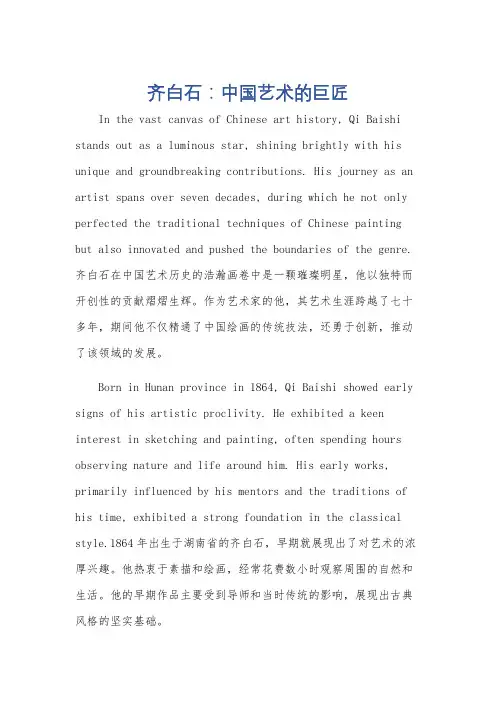
齐白石:中国艺术的巨匠In the vast canvas of Chinese art history, Qi Baishi stands out as a luminous star, shining brightly with his unique and groundbreaking contributions. His journey as an artist spans over seven decades, during which he not only perfected the traditional techniques of Chinese painting but also innovated and pushed the boundaries of the genre.齐白石在中国艺术历史的浩瀚画卷中是一颗璀璨明星,他以独特而开创性的贡献熠熠生辉。
作为艺术家的他,其艺术生涯跨越了七十多年,期间他不仅精通了中国绘画的传统技法,还勇于创新,推动了该领域的发展。
Born in Hunan province in 1864, Qi Baishi showed early signs of his artistic proclivity. He exhibited a keen interest in sketching and painting, often spending hours observing nature and life around him. His early works, primarily influenced by his mentors and the traditions of his time, exhibited a strong foundation in the classical style.1864年出生于湖南省的齐白石,早期就展现出了对艺术的浓厚兴趣。
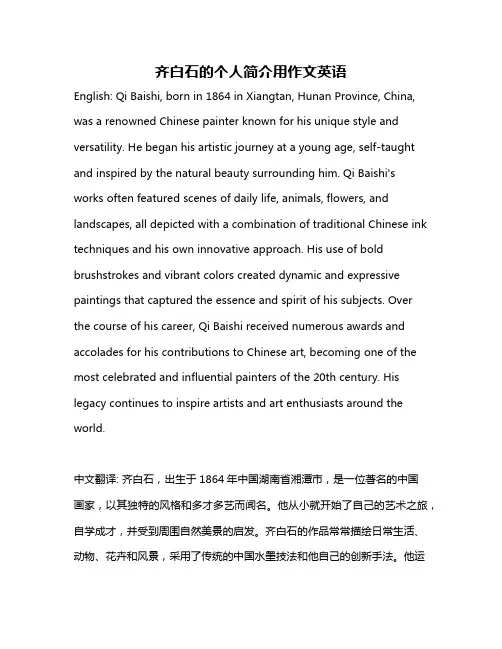
齐白石的个人简介用作文英语English: Qi Baishi, born in 1864 in Xiangtan, Hunan Province, China, was a renowned Chinese painter known for his unique style and versatility. He began his artistic journey at a young age, self-taught and inspired by the natural beauty surrounding him. Qi Baishi's works often featured scenes of daily life, animals, flowers, and landscapes, all depicted with a combination of traditional Chinese ink techniques and his own innovative approach. His use of bold brushstrokes and vibrant colors created dynamic and expressive paintings that captured the essence and spirit of his subjects. Over the course of his career, Qi Baishi received numerous awards and accolades for his contributions to Chinese art, becoming one of the most celebrated and influential painters of the 20th century. His legacy continues to inspire artists and art enthusiasts around the world.中文翻译: 齐白石,出生于1864年中国湖南省湘潭市,是一位著名的中国画家,以其独特的风格和多才多艺而闻名。
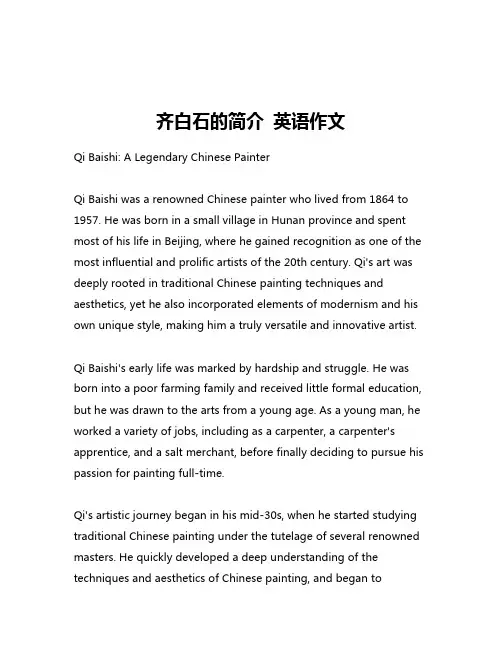
齐白石的简介英语作文Qi Baishi: A Legendary Chinese PainterQi Baishi was a renowned Chinese painter who lived from 1864 to 1957. He was born in a small village in Hunan province and spent most of his life in Beijing, where he gained recognition as one of the most influential and prolific artists of the 20th century. Qi's art was deeply rooted in traditional Chinese painting techniques and aesthetics, yet he also incorporated elements of modernism and his own unique style, making him a truly versatile and innovative artist.Qi Baishi's early life was marked by hardship and struggle. He was born into a poor farming family and received little formal education, but he was drawn to the arts from a young age. As a young man, he worked a variety of jobs, including as a carpenter, a carpenter's apprentice, and a salt merchant, before finally deciding to pursue his passion for painting full-time.Qi's artistic journey began in his mid-30s, when he started studying traditional Chinese painting under the tutelage of several renowned masters. He quickly developed a deep understanding of the techniques and aesthetics of Chinese painting, and began toexperiment with his own unique style. Qi's early works were heavily influenced by the traditional Chinese landscape painting style, with their emphasis on the natural world and the use of bold, expressive brushstrokes.Over the course of his career, Qi Baishi's style evolved and became increasingly abstract and experimental. He began to incorporate elements of modernism into his work, such as the use of bright, vibrant colors and a more dynamic compositional approach. At the same time, he remained deeply rooted in the traditions of Chinese painting, and his works continued to reflect a deep appreciation for the natural world and the beauty of the human form.One of the most distinctive features of Qi Baishi's art was his use of the xieyi style, a type of Chinese painting that emphasizes spontaneity and expressiveness over technical precision. Qi's xieyi paintings were characterized by their bold, gestural brushstrokes and their ability to capture the essence of a subject rather than its physical details. This approach allowed Qi to create works that were both visually striking and emotionally evocative.Another hallmark of Qi Baishi's art was his fascination with the natural world. Many of his paintings depict scenes from the countryside, such as landscapes, animals, and plants. Qi had a deep respect for the natural world and sought to capture its beauty andcomplexity in his art. His paintings of crabs, shrimp, and other marine creatures were particularly renowned for their attention to detail and their ability to convey the movement and vitality of these creatures.Throughout his career, Qi Baishi received numerous accolades and honors for his contributions to the world of art. He was recognized as a master painter by the Chinese government and was awarded the title of "National Treasure" in 1953. His works were highly sought after by collectors and museums around the world, and he is still widely regarded as one of the most important and influential Chinese artists of the 20th century.Despite his success and recognition, Qi Baishi remained a humble and unassuming man throughout his life. He was known for his kindness, his generosity, and his willingness to share his knowledge and expertise with younger artists. Many of his students went on to become successful painters in their own right, and Qi's legacy continues to inspire and influence artists around the world.In conclusion, Qi Baishi was a truly remarkable artist who left an indelible mark on the world of Chinese painting. His unique style, his deep connection to the natural world, and his unwavering dedication to his craft have made him one of the most respected and admired artists of the 20th century. His legacy continues to inspire andcaptivate art lovers around the world, and his works remain a testament to the enduring power and beauty of Chinese art.。
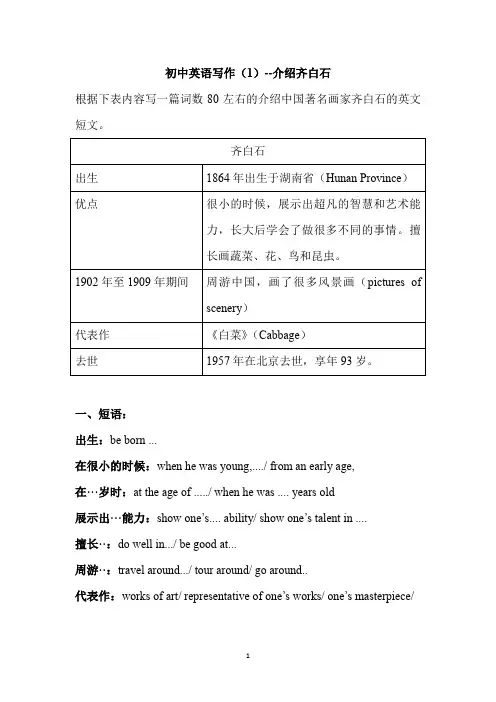
初中英语写作(1)--介绍齐白石根据下表内容写一篇词数80左右的介绍中国著名画家齐白石的英文短文。
一、短语:出生:be born ...在很小的时候:when he was young,..../ from an early age,在···岁时:at the age of ...../ when he was .... years old展示出···能力:show one’s.... ability/ show one’s talent in ....擅长··:do well in.../ be good at...周游··:travel around.../ tour around/ go around..代表作:works of art/ representative of one’s works/ one’s masterpiece/二、写作句子:1.齐白石是一名著名的中国画家。
Qi Baishi was a famous Chinese painter. (因为已经去世了,所以用was) 2.1864年他出生于湖南省。
He was born in Hunan Province in 1864.3.在很小的时候,他就展示出了超凡的智慧和艺术能力。
From an early age, he showed his great intelligence and artistic ability. When he was young, he showed his talents in art and intelligence.第2句和第3句可以合并。
Born in Hunan Province in 1864, he showed his great intelligence and artistic ability.4.当他长大,他学会了做很多不同的事情。
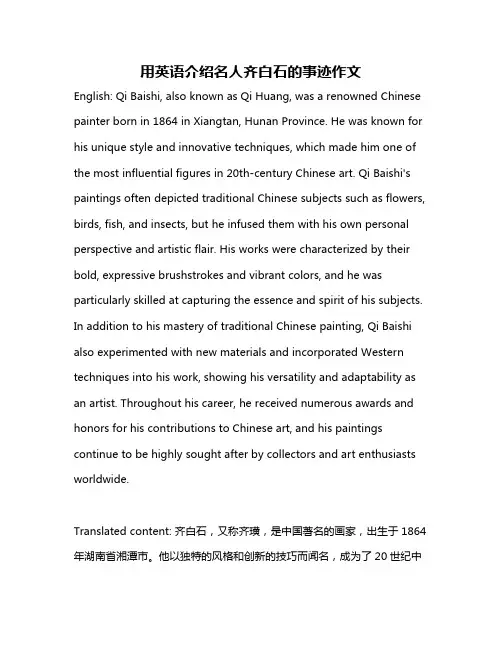
用英语介绍名人齐白石的事迹作文English: Qi Baishi, also known as Qi Huang, was a renowned Chinese painter born in 1864 in Xiangtan, Hunan Province. He was known for his unique style and innovative techniques, which made him one of the most influential figures in 20th-century Chinese art. Qi Baishi's paintings often depicted traditional Chinese subjects such as flowers, birds, fish, and insects, but he infused them with his own personal perspective and artistic flair. His works were characterized by their bold, expressive brushstrokes and vibrant colors, and he was particularly skilled at capturing the essence and spirit of his subjects. In addition to his mastery of traditional Chinese painting, Qi Baishi also experimented with new materials and incorporated Western techniques into his work, showing his versatility and adaptability as an artist. Throughout his career, he received numerous awards and honors for his contributions to Chinese art, and his paintings continue to be highly sought after by collectors and art enthusiasts worldwide.Translated content: 齐白石,又称齐璜,是中国著名的画家,出生于1864年湖南省湘潭市。
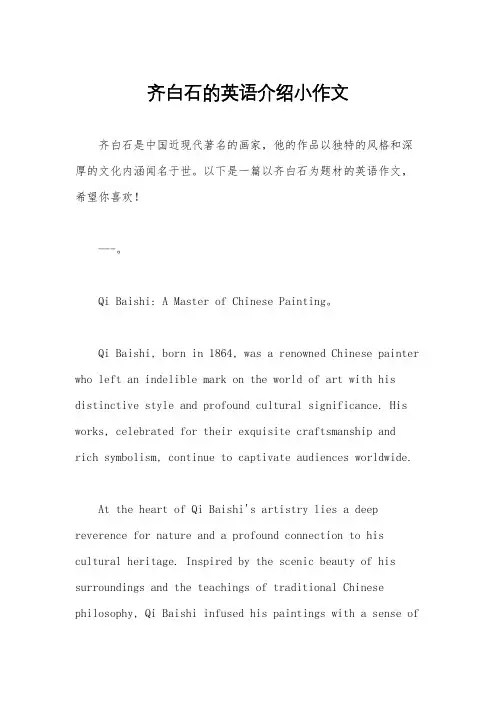
齐白石的英语介绍小作文齐白石是中国近现代著名的画家,他的作品以独特的风格和深厚的文化内涵闻名于世。
以下是一篇以齐白石为题材的英语作文,希望你喜欢!---。
Qi Baishi: A Master of Chinese Painting。
Qi Baishi, born in 1864, was a renowned Chinese painter who left an indelible mark on the world of art with his distinctive style and profound cultural significance. His works, celebrated for their exquisite craftsmanship andrich symbolism, continue to captivate audiences worldwide.At the heart of Qi Baishi's artistry lies a deep reverence for nature and a profound connection to his cultural heritage. Inspired by the scenic beauty of his surroundings and the teachings of traditional Chinese philosophy, Qi Baishi infused his paintings with a sense ofharmony and tranquility that transcends time and space.One of Qi Baishi's most iconic subjects is the humble shrimp. In his hands, this seemingly ordinary creature becomes a symbol of resilience and perseverance, depicted with meticulous detail and subtle brushwork. Through his shrimp paintings, Qi Baishi invites viewers to contemplate the beauty and complexity of the natural world, urging us to cherish and protect it for future generations.In addition to his mastery of traditional Chinese painting techniques, Qi Baishi was also a pioneer in the use of color and composition. His bold experimentation with vibrant hues and innovative compositions breathed new life into the age-old art form, inspiring generations of artists to push the boundaries of their craft.Qi Baishi's artistic legacy extends far beyond the canvas. As a passionate educator and advocate for cultural preservation, he dedicated himself to passing on the traditions of Chinese painting to future generations. Through his teachings and writings, Qi Baishi sought toinstill in others a deep appreciation for the beauty and wisdom of traditional Chinese art.Today, Qi Baishi's paintings are cherished treasures held in museums and private collections around the world. Each brushstroke is a testament to his extraordinary talent and unwavering dedication to his craft. Through his art, Qi Baishi continues to bridge the gap between East and West, inviting people of all backgrounds to experience the timeless beauty of Chinese culture.In conclusion, Qi Baishi's contributions to the worldof art are immeasurable. His mastery of painting techniques, deep reverence for nature, and dedication to cultural preservation have earned him a place of honor in the annals of art history. As we admire his exquisite works, let us also reflect on the wisdom and beauty that continue to inspire and enrich our lives.---。
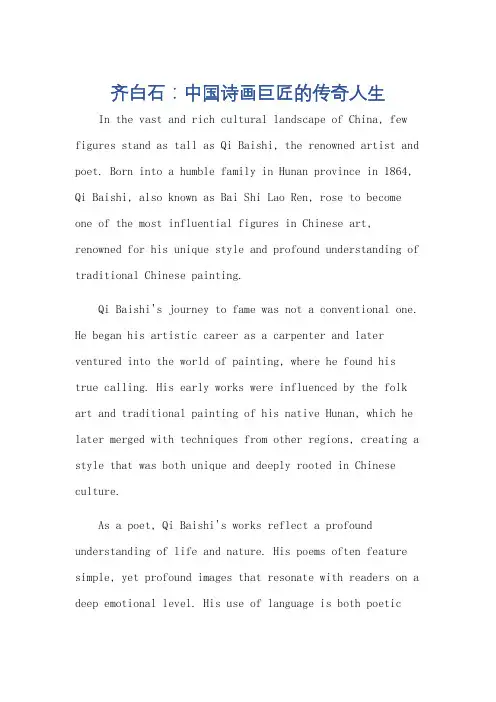
齐白石:中国诗画巨匠的传奇人生In the vast and rich cultural landscape of China, few figures stand as tall as Qi Baishi, the renowned artist and poet. Born into a humble family in Hunan province in 1864, Qi Baishi, also known as Bai Shi Lao Ren, rose to become one of the most influential figures in Chinese art, renowned for his unique style and profound understanding of traditional Chinese painting.Qi Baishi's journey to fame was not a conventional one. He began his artistic career as a carpenter and later ventured into the world of painting, where he found his true calling. His early works were influenced by the folk art and traditional painting of his native Hunan, which he later merged with techniques from other regions, creating a style that was both unique and deeply rooted in Chinese culture.As a poet, Qi Baishi's works reflect a profound understanding of life and nature. His poems often feature simple, yet profound images that resonate with readers on a deep emotional level. His use of language is both poeticand profound, often incorporating elements of traditional Chinese poetry while maintaining a contemporary relevance. Qi Baishi's paintings, too, are a testament to his exceptional talent and deep understanding of Chinese art. His works often feature simple subjects like insects, flowers, and birds, yet he manages to convey a sense of serenity and tranquility that is deeply calming and uplifting. His use of color and brushwork is masterful, with each stroke carrying a sense of life and energy that is both captivating and inspiring.Qi Baishi's legacy is not just in his art but also in his unwavering commitment to preserving and promoting Chinese culture. He was a staunch advocate of traditional Chinese painting and poetry, yet he was also open to innovation and experimentation. His works are a testament to his belief that art should be a bridge between tradition and modernity, a belief that has resonated with generations of artists and art lovers.In conclusion, Qi Baishi was not just an artist or a poet; he was a cultural icon and a national treasure. His life and works are a testament to the richness and depth ofChinese culture, and his legacy will continue to inspireand influence artists and art lovers from around the world. **齐白石:诗画巨匠的传奇人生**在中国博大精深的文化景观中,齐白石这位著名的艺术家和诗人堪称独树一帜。
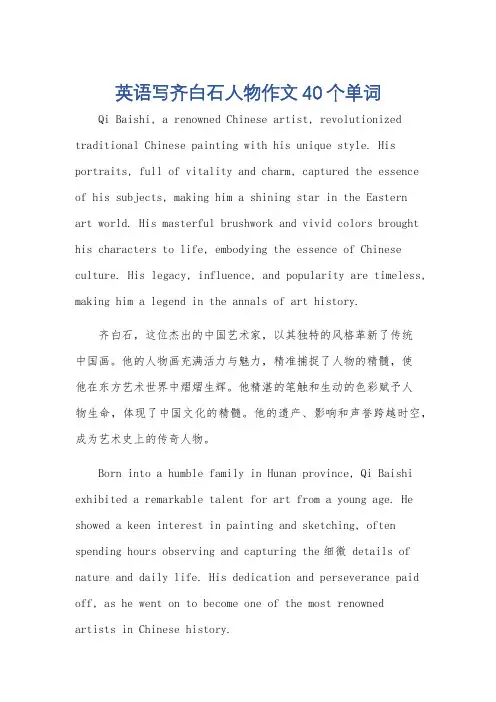
英语写齐白石人物作文40个单词Qi Baishi, a renowned Chinese artist, revolutionized traditional Chinese painting with his unique style. His portraits, full of vitality and charm, captured the essence of his subjects, making him a shining star in the Easternart world. His masterful brushwork and vivid colors brought his characters to life, embodying the essence of Chinese culture. His legacy, influence, and popularity are timeless, making him a legend in the annals of art history.齐白石,这位杰出的中国艺术家,以其独特的风格革新了传统中国画。
他的人物画充满活力与魅力,精准捕捉了人物的精髓,使他在东方艺术世界中熠熠生辉。
他精湛的笔触和生动的色彩赋予人物生命,体现了中国文化的精髓。
他的遗产、影响和声誉跨越时空,成为艺术史上的传奇人物。
Born into a humble family in Hunan province, Qi Baishi exhibited a remarkable talent for art from a young age. He showed a keen interest in painting and sketching, often spending hours observing and capturing the细微 details of nature and daily life. His dedication and perseverance paid off, as he went on to become one of the most renownedartists in Chinese history.齐白石出生于湖南一个普通家庭,从小就展现出非凡的艺术天赋。
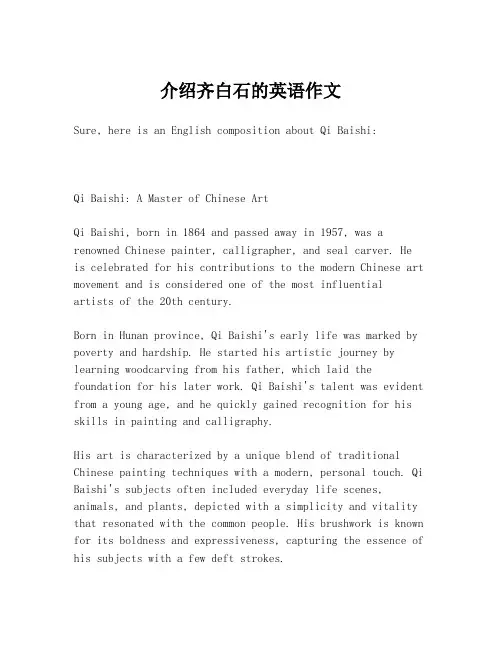
介绍齐白石的英语作文Sure, here is an English composition about Qi Baishi:Qi Baishi: A Master of Chinese ArtQi Baishi, born in 1864 and passed away in 1957, was a renowned Chinese painter, calligrapher, and seal carver. Heis celebrated for his contributions to the modern Chinese art movement and is considered one of the most influentialartists of the 20th century.Born in Hunan province, Qi Baishi's early life was marked by poverty and hardship. He started his artistic journey by learning woodcarving from his father, which laid the foundation for his later work. Qi Baishi's talent was evident from a young age, and he quickly gained recognition for his skills in painting and calligraphy.His art is characterized by a unique blend of traditional Chinese painting techniques with a modern, personal touch. Qi Baishi's subjects often included everyday life scenes, animals, and plants, depicted with a simplicity and vitality that resonated with the common people. His brushwork is known for its boldness and expressiveness, capturing the essence of his subjects with a few deft strokes.One of Qi Baishi's most famous works is "The Twelve Landscape Screens," a series of paintings that showcase his mastery of ink and brush. These screens are a testament to his ability to evoke the spirit of the natural world through his art.Qi Baishi's influence extends beyond his paintings. He was also a skilled calligrapher and seal carver, with his seals being highly sought after for their artistic value and the personal touch they added to his paintings.Despite his humble beginnings, Qi Baishi's art has left an indelible mark on Chinese culture. His work is admired forits accessibility and the way it captures the beauty of everyday life. His legacy continues to inspire artists andart lovers alike, making him a true icon in the world of Chinese art.In conclusion, Qi Baishi's art embodies the spirit of traditional Chinese painting while also reflecting a modern sensibility. His life and work serve as a reminder of the power of art to transcend social and economic barriers and to touch the hearts of people across generations.This composition provides a concise overview of Qi Baishi's life, artistic style, and contributions to Chinese art, suitable for an English language essay.。
一篇齐白石英文作文English:Qi Baishi, also known as Ch'i Pai-shih, was a renowned Chinese painter who lived from 1864 to 1957. He was famous for his innovative and unique painting style, which combined traditional Chinese painting techniques with a more modern and individualistic approach. His art often featured aspects of nature, such as birds, insects, and flowers, and he had a particular talent for capturing the essence and spirit of these subjects in his work. Qi Baishi's work was highly praised for its simplicity and elegance, and he became one of the most influential Chinese artists of the 20th century. His legacy continues to impact and inspire artists around the world.中文翻译:齊白石,又被称为齐白石,是一位著名的中国画家,生于1864年,卒于1957年。
他以创新独特的绘画风格而闻名,将传统的中国绘画技巧与更现代、个性化的手法相结合。
他的艺术经常以自然为主题,如鸟、昆虫和花卉,他在捕捉这些主题的本质和精神方面特别有才华。
小学英语作文齐白石English:Qi Baishi, also known as Qi Huang, was a renowned Chinese painter and is considered one of the most important Chinese artists of the 20th century. He was born in 1864 in Xiangtan, Hunan Province, and began learning how to paint at a young age. Qi Baishi was known for his unique style, blending traditional Chinese painting techniques with a more modern approach. His works often featured subjects such as flowers, birds, and landscapes, and he was particularly skilled at painting shrimp and other small creatures. Qi Baishi's art was widely praised for its simplicity and expressiveness, and he has had a lasting influence on Chinese painting.中文翻译:齐白石,又名齐黄,是一位著名的中国画家,被认为是20世纪中国最重要的艺术家之一。
他出生于1864年,出生在湖南省湘潭市,从小就开始学习绘画。
齐白石以其独特的风格而闻名,将传统的中国绘画技巧与更现代化的方式相结合。
他的作品常常以花鸟和风景为主题,尤其擅长画虾和其他小动物。
齐白石的艺术因其简洁和富有表现力而受到广泛赞扬,并对中国绘画产生了深远的影响。
关于齐白石的英语作文Title: Qi Baishi: A Master of Chinese Painting。
Qi Baishi (1864-1957) was a renowned Chinese painter known for his distinctive style and mastery of traditional Chinese painting techniques. Born in Xiangtan, Hunan Province, Qi Baishi's artistic talent manifested at an early age. Despite facing numerous challenges throughout his life, including poverty and limited formal education, Qi Baishi's passion for art remained unwavering, eventually propelling him to become one of the most celebrated artists in Chinese history.Qi Baishi's artistic journey began with his apprenticeship to a local craftsman, where he learned the fundamentals of painting and calligraphy. Through sheer determination and relentless practice, he gradually honed his skills and developed a unique style characterized byits simplicity, expressiveness, and rich symbolism.One of Qi Baishi's most notable contributions to Chinese art is his innovative approach to traditional subjects. While he drew inspiration from classical Chinese paintings, he infused them with his own interpretations and personal experiences, breathing new life into familiar themes such as flowers, birds, insects, and landscapes. His compositions often exude a sense of vitality and spontaneity, reflecting his deep connection to nature and the world around him.Qi Baishi's artistic repertoire encompassed a wide range of subjects, but he was particularly renowned for his depictions of shrimps, lotus flowers, and other humble objects. Through meticulous brushwork and exquisite detailing, he transformed ordinary subjects into extraordinary works of art, elevating the mundane to the realm of the sublime. His ability to imbue his paintings with layers of meaning and emotion captivated audiences both in China and abroad, earning him widespread acclaim as a master of his craft.In addition to his technical prowess, Qi Baishi wasalso admired for his humility and generosity. Despite achieving fame and fortune in his later years, he remained deeply rooted in his humble origins and maintained a simple and frugal lifestyle. He often gave away his paintings to friends, students, and admirers, demonstrating his genuine love for art and his desire to share its beauty with others.Qi Baishi's legacy continues to resonate in the worldof Chinese art and beyond. His influence can be seen in the works of countless artists who have been inspired by his innovative spirit and dedication to his craft. Moreover,his emphasis on creativity, originality, and the expressive power of art continues to inspire generations of artists to this day.In conclusion, Qi Baishi's contributions to Chinese painting are immeasurable. Through his mastery of technique, innovative approach to subject matter, and unwavering dedication to his craft, he has left an indelible mark onthe history of Chinese art. His paintings continue to enchant audiences with their timeless beauty and profoundinsights, ensuring that his legacy will endure for generations to come.。
齐白石40字英语作文翻译Title: A Glimpse into Qi Baishi's Artistic Legacy。
Qi Baishi, renowned for his exquisite Chinese paintings, left an indelible mark on the world of art. His masterpieces captivate viewers with their intricate details and profound symbolism.Born in 1864 in Hunan Province, Qi Baishi's artistic journey began humbly. Despite facing numerous challenges,he persevered, honing his skills and developing his unique style. Through his artwork, he immortalized the beauty of nature and everyday life, infusing his paintings withvitality and emotion.Qi Baishi's compositions often feature subjects like flowers, birds, fish, and insects, reflecting his deep reverence for the natural world. His brushstrokes, characterized by spontaneity and fluidity, breathe lifeinto his creations, evoking a sense of harmony andtranquility.One of his most iconic works, "Shrimps," showcases his meticulous attention to detail and his ability to convey the essence of his subjects. Each shrimp seems to comealive on the canvas, their delicate forms rendered with precision and grace.In addition to his technical prowess, Qi Baishi's art is imbued with symbolism and cultural significance. His paintings frequently incorporate auspicious motifs, such as peaches for longevity and lotus flowers for purity and enlightenment. Through these symbols, he conveys timeless messages of hope, prosperity, and spiritual growth.Qi Baishi's influence extends far beyond the realm of art. He was not only a master painter but also a respected teacher and mentor, inspiring countless aspiring artists with his wisdom and passion. His dedication to his craft and his unwavering commitment to artistic expression continue to inspire generations of creators around the world.In conclusion, Qi Baishi's legacy is a testament to the power of art to transcend boundaries and connect people across cultures and generations. His paintings serve as windows into a world of beauty, wisdom, and wonder, reminding us of the enduring value of creativity and imagination. As we contemplate his works, we are invited to explore the boundless possibilities of the human spirit and to find inspiration in the simplest joys of life.。
齐白石英文简介齐白石,近现代中国绘画大师,世界文化名人。
曾任中央美术学院名誉教授、中国美术家协会主席等职。
下面是小编为你整理的齐白石英文简介,希望对你有用!齐白石简介Qi Baishi (January 1, 1864 - September 16, 1957), native of Anhui Province, Dangshan, was born in Changsha, Hunan Xiangtan (now Hunan Xiangtan).Formerly known as pure Chi, the word Wei, No. Lanting. After renamed Juan, the word end of life, No. Whitehead, Whitehead Hill Weng, old Ping, hungry old man, by the mountain Yin Museum Lord, send Ping Tong old man, three hundred stone inscriptions.Is a modern Chinese painting master, world cultural celebrity. Early years for the carpentry, after the painting for a living, after the age of fifty-five settled in Beijing. Good at flowers and birds, insect fish, landscapes, figures, ink vigorous moisturizing, bright colors bright and bright, simple and vivid shape, the mood is simple and honest. Made fish and shrimp insect crab, days interesting.Qi Baishi book seal, take the seal in the Qin and Han Dynasties, the book Rao ancient Zhuo of interest, seal a self, a good writing poetry. Former honorary professor of the Central Academy of Fine Arts, chairman of the Chinese Artists Association and other staff. Representative of the frog ten miles out of the spring shrimp and so on. Author of Whitehead poetry grass White stone old man read and soon.齐白石生平经历January 1, 1864 (lunar calendar year in 1863 winter twenty-two days), Qi Baishi was born in Changsha, Hunan Xiang Xiangtan white stone shop apricot dock star dish pond. Name pure Chi, the word Wei Qing, and word Lanting. 27-year-old renamed Juan, word frequency students, alias white stone mountain people, and also send garden.In 1870, from the grandfather Zhou Yu if reading, commonly used books, books thin paper painting.In 1878, thanks to the United States as a teacher to learn carved carpenter. Do carpentry, to the residual mustard garden as a teacher, learning flowers and birds, figure painting.In 1888, thanks to folk artists Xiao Xiang 陔 portrait for the teacher painting.In 1889, thanks to Hu Patio, Chen Shao Fan as a teacher poetry, was Hu Qinyuan help, from the woodworker life, study painting, portrait for the family.In 1894, and Wang Zhongyan and other seven knot Longshan Poetry Society , was elected president. And after Li Songan Temple and other knot Luoshan Poetry Society , together with poetry, painting, carved stone.In 1899, thanks to Xiangtan celebrities Wang Kaiyun as a teacher to learn poetry. With the first annual publication of the printed map send garden printed , printing Ding Jing, Huang Yi, sophisticated rules, can be true.In 1900, living in the lotus peak under the Mei Gongci, claiming to Bai Mei book house , and in the hospital built a small house, the name by the mountain museum. Committed to painting, poetry.In 1902, at the invitation of Xia Yi Yi, went to Xi an to teach. In Xi an to get to know Fan Fan Shan, do the view of the possession of eight mountains, Jinnong and other famous painting and calligraphy. Is the year, the flowers and birds of a unique style, embarked on a freehand painting path.In 1903, from Xi an to Beijing, met Zeng Xi, Li Ruquan, etc., during the summer afternoon Yi Yi proposed to the Empress Dowager Cixi recommended Qi Baishi to do the inner court, Summer, from Beijing to Shanghai, back to Hunan, this is the five out of five for the first time travel.In 1904, with Wang Kaiyun went to Jiangxi, travel Lushan, Nanchang and other places, published white stone grass clothing character carved , Wang Kaiyun for its order.In 1905, went to Guangxi, tour Guilin. And Cai E, Huang Xing acquaintance.In 1906, after the Spring Festival, Wuzhou by the Guangzhou to Qinzhou, Guo Baosheng left its teaching. Enjoy the possession of Guo Xu Wei, eight, Jinnong famous authentic. Work with paintings, during which often Guo Dai pen. Autumn, back to Xiangtan, to teach painting salary to buy the old house and dozens of acres of paddy fields.1907, the spring and summer of the turn, then go to Qinzhou, tour Zhaoqing, Duanxi. Winter, back to Xiangtan.In 1908, spring went to Guangzhou. Is the year, only to live back to Xiangtan a few days, the rest of the time spent in Guangzhou.In 1909, after the Spring Festival in Guangzhou, after Qinzhou. Early summer to Shanghai, to sell paintings for a living. Between summer and autumn, travel Suzhou. To visit Nanjing Li Meiyan, for its governance tripartite. October return to Xiangtan, thus ending the five out of five travel far life. Then in the home repair send Ping Church , began 8 years of mountain life, painstakingly painted poetry. On the eight mountain people, stone Tao flowers and more paintings, the brush more concise, but the grass insects sketch, more work, or to write out of the free. Calligraphy learn gold farmers, get their marrow.In 1917, to avoid the bandits to Beijing. Is to catch up with Zhang Xun restoration , rush to Tianjin asylum. The situation is slightly scheduled, return to Beijing, in the glass factory south of the paper shop hanging Runge painting. Period and old friends Fan Fan Shan, Xia Wu Yi, Guo Baosheng and other contacts very close. And meet ChenShizeng, Yao Mang father, Chen and so on. Which has been set with Chen Shi, Qi Bai Shi had a great impact on old age. Is the winter, leaving Beijing to return to Hunan, rural one year.In 1919, married with Hu Baozhu, from Beijing.In 1923, Chen Shi had died in Nanjing, several times poems mourning friends. 1925, spring, serious illness, personnel do not know seven days and nights. Waiting for more than a month, stop painting, engraved. Mei Lanfang officially apprenticeship painting.In 1926, the mother and father died one after another. Twice to stop painting, engraved.In 1927, at the invitation of Lin Fengmian, taught at the Beijing Art College.1928, the printing of white stone poetry grass by the mountain museum poetry grass (handwritten copy)1933, printed white stone poetry grass (eight volumes of printed)1936, travel Sichuan. In the Chuan know Huang Binhong.In 1937, listen to Changsha Shu Yi on the fortune-telling said, with the deceived, since the 77-year-old. In July, Peiping fall, feeling grievous, easy to see customers.In 1940, the lunar month, his wife died in Chen Junchun, wrote Lady Chen text. To resist the Japanese and traitors harassment cable painting, posted painting does not sell and official home confession, declined to see customers.In 1944 January, following the room Hu Baozhu died. In June, refused to Peiping Art assigned to coal.In 1946, the end of the war, complex and then in the glass factory hanging Runge, restore the sale of engraving. In October, go to Nanjing, Shanghai to do the exhibition, more than 200 paintings all sold, bring back a bundle of French , as waste paper, actually can not buy 10 bags of flour.In January 1949, Beiping liberated. To attend the premier reception of Chou Enlai. For Mao Zedong carved stone two sides. As honorary professor of the Central Academy of Fine Arts.In 1950, he was hired as a librarian. In April, had dinner with Mao Zedong, Zhu De to accompany. In October, the 82-year-old made the eagle and seal book couplet sea for the dragon world, the cloud is the crane home presented Mao Zedong. To participate in the Beijing anti-Korean aid painting and calligraphy exhibition . Winter, for the People s Daily painting peace dove In February 1951, more than 10 paintings to participate in Shenyang City, the Korean War Painting and Calligraphy Exhibition .In 1952, with three days, for the Beijing Asia-Pacific RegionalPeace Conference to create a huge two white and peace dove. In the same year, many works entitled Peace Victory and Peaceful Long Live .January 7, 1953, Beijing cultural and art circles more than 200 people to participate in Qi Baishi 90 birthday celebration , the Ministry of Culture awarded Qi Baishi outstanding people artisttitle. Zhou Enlai attended the evening celebration banquet. Served as chairman of the Beijing Chinese Painting Research Association in October, was elected chairman of the first Chinese ArtistsAssociation Council.April 28, 1954, the Chinese Artists Association in the Palace Museum held Qi Baishi painting exhibition in August, was elected to the National People s Congress. September 15, attended the first National People s Congress.June 1955, and Chen Min Ding, He Xiangning and other 14 painters for the World Peace Assembly cooperation huge peaceApril 27, 1956, the World Peace Council announced the grant of Qi Baishi International Peace Prize, September 1, held a grand ceremonyin Beijing. Premier Zhou Enlai personally congratulated.May 15, 1957, served as honorary president of Beijing Chinese Painting Academy. 5 - June, for the last piece of work Peony . September 16, died at the Beijing hospital. September 22 morning in Jiaxing Temple held a public offering, Premier Zhou Enlai and other central leaders participated in the public offering.In 1963, Qi Baishi was selected as one of the world s top ten cultural celebrities. (Note: the network confirmed that the world s top ten cultural celebrities and no Qi Baishi, the world s top ten cultural celebrities: Confucius, Plato, Aristotle, Copernicus, Newton, Darwin, Bacon, Aquinas, Voltaire, Kant.)齐白石英文简介相关。